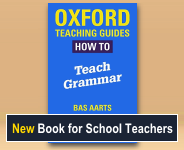Glossary: tag question
Explanation
A short question added to the end of a clause, such as did he? or wasn’t there?. These short additional interrogative clauses are usually incomplete and refer back to the main clause of the sentence, as in ...there was a large picture of your mother's mother wasn't there?[S1A-007 #167]. Tag questions are common in conversational speech, frequently used to seek agreement.Englicious contains many resources for English language in schools, but the vast majority of them require you to register and log in first. For more information, see What is Englicious?

